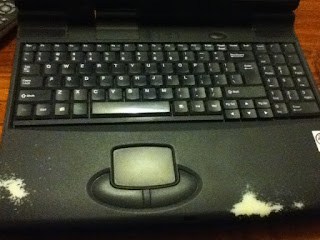The basic overview. The tag in the back right corner is a repair tag from when grandpa got it fixed at some stage.
A view of the screen, keyboard and mousepad. the screen and keyboard should be re-usable but I'll need to find a new mousepad and buttons.
Some views of the bottom. At bottom with all of the removable sections partly removed. Clockwise from top right there is the CDROM drive, HDD bay, Floppy/Zip drive bay.
Here all of the removable modules are removed. Bottom left we can see the modem module with broken ribbon cable from a previous teardown I did.
Here is the backplate with (L to R) VGA out, RS-232, 2xUSB, proprietry breakout plug, RCA video out, S-Video out, Printer port.2.5" HDD bay.
CDROM sitting on top of HDD bay to get some angle on the front.
Zip and Floppy drives side by side on top of HDD on top of CDROM, once again for some angle.
A close up of the connector. Should be pretty easy for me to put in my own connectors.
The where the battery was. It's a pretty big hole and a raspberry pi would probably fit in this space alone. Maybe some other pluggable module... Perhaps a replaceable CPU/RAM module or something.
The battery in all it's brick-like glory. It doesn't work as a battery anymore but if I did want to I could probably re-pack the original cells... Perhaps even increasing the capacity. :)
If you want any more detailed pictures or info post a comment and I'll get some for you.















